Gaps, Trends and Challenges in Assessing Quality of Service at Airport Terminals: A Systematic Review and Bibliometric Analysis
Abstract
1. Introduction
2. Review Methodology
3. Results and Discussion
3.1. Places of Application
3.2. Airport Areas
3.3. Evaluators Profile
3.4. Methods
3.5. Evaluation Criteria
4. Conclusions
Author Contributions
Funding
Institutional Review Board Statement
Informed Consent Statement
Data Availability Statement
Acknowledgments
Conflicts of Interest
Appendix A
| No. | Title | Journal |
|---|---|---|
| 1 | Level of service design concept for airport passenger terminals: A european view | Transportation Planning and Technology |
| 2 | A framework for evaluating level of service for airport terminals | Transportation Planning and Technology |
| 3 | Variables influencing performance of air terminal building | Transportation Planning and Technology |
| 4 | Evaluation of transportation level of service using fuzzy sets | Transportation Research Record |
| 5 | A methodology for establishing operational standards of airport passenger terminals | Journal of Air Transport Management |
| 6 | Developing a quality index for US airports | Managing Service Quality |
| 7 | Measuring the level of services at airport passenger terminals: Comparison of perceived and observed time | Transportation Research Record |
| 8 | User-perceived level-of-service evaluation model for airport baggage-handling systems | Transportation Research Record |
| 9 | Evaluating passenger services of Asia-Pacific international airports | Transportation Research Part E: Logistics and Transportation Review |
| 10 | Wayfinding in the passenger terminal of Hong Kong International Airport | Journal of Air Transport Management |
| 11 | Evaluating level of service at airport passenger terminals: Review of research approaches | Transportation Research Record |
| 12 | Determination of service levels for passenger orientation in Hong Kong International Airport | Journal of Air Transport Management |
| 13 | Measuring service quality at King Fahd International Airport | International Journal of Services and Standards |
| 14 | Airport security screening and changing passenger satisfaction: An exploratory assessment | Journal of Air Transport Management |
| 15 | Tourism service quality begins at the airport | Tourism Management |
| 16 | Passengers’ expectations of airport service quality | Journal of Services Marketing |
| 17 | Development of level of service standards for airport facilities: Application to São Paulo International Airport | Journal of Air Transport Management |
| 18 | Evaluation of level of service for transfer passengers at airports | Journal of Air Transport Management |
| 19 | Overall level of service measures for airport passenger terminals | Transportation Research Part A: Policy and Practice |
| 20 | Analysis of level of service at airport departure lounges: User perception approach | Journal of Transportation Engineering |
| 21 | Quantifying and validating measures of airport terminal wayfinding | Journal of Air Transport Management |
| 22 | A global index for level of service evaluation at airport passenger terminals | Transportation Research Part E: Logistics and Transportation Review |
| 23 | Voice of Turkish customer: Importance of expectations and level of satisfaction at airport facilities | Review of European Studies |
| 24 | An ordinal logistic regression model for analysing airport passenger satisfaction | EuroMed Journal of Business |
| 25 | A model for the evaluation of airport service quality | Proceedings of the Institution of Civil Engineers: Transport |
| 26 | A quality approach to airport management | Quality & Quantity |
| 27 | Level of service analysis for airport baggage claim with a case study of the Calgary International Airport | Journal of Advanced Transportation |
| 28 | Combining VIKOR with GRA techniques to evaluate service quality of airports under fuzzy environment | Expert Systems with Applications |
| 29 | A gap analysis model for improving airport service quality | Total Quality Management & Business Excellence |
| 30 | Measuring quality of service in airport passenger terminals | Transportation Research Record |
| 31 | An application of the airport service quality model in South Africa | Journal of Air Transport Management |
| 32 | A decision rules approach for improvement of airport service quality | Expert Systems with Applications |
| 33 | A hybrid approach for multi-criteria evaluation of airport service quality | International Journal of Services and Standards |
| 34 | Evaluating the quality of airport service using the fuzzy multi-criteria decision-making method: A case study of Taiwanese airports | Expert Systems |
| 35 | Airport service quality drivers of passenger satisfaction | Tourism Review |
| 36 | A method for evaluating the level of service arrival components at airports | Journal of Air Transport Management |
| 37 | Customer service in the aviation industry - An exploratory analysis of UAE airports | Journal of Air Transport Management |
| 38 | ASQual: Measuring tourist perceived service quality in an airport setting | International Journal of Business Excellence |
| 39 | Fuzzy ServPerf model combined with ELECTRE III to comparatively evaluate service quality of international airports in Sicily | Journal of Air Transport Management |
| 40 | The effects of service quality dimensions and passenger characteristics on passenger’s overall satisfaction with an airport | Journal of Air Transport Management |
| 41 | Passengers’ perspective toward airport service quality: The comparison between TPE and TSA | Journal of Aeronautics, Astronautics and Aviation: Series A |
| 42 | Performance measurement in airport settings: a systematic literature review | Benchmarking: An International Journal |
| 43 | A Robust Multi-Criteria Decision-Making Framework for Evaluation of the Airport Service Quality Enablers for Ranking the Airports | Journal of Quality Assurance in Hospitality & Tourism |
| 44 | Analysis of the operational performance of brazilian airport terminals: A multicriteria approach with De Borda-AHP integration | Journal of Air Transport Management |
| 45 | Evaluating service quality of airports with integrating TOPSIS and VIKOR under fuzzy environment | International Journal of Services, Economics and Management |
| 46 | Exploring different nationality perceptions of airport service quality | Journal of Air Transport Management |
| 47 | Measuring airport service quality: A multidimensional approach | Journal of Air Transport Management |
| 48 | An assessment of passenger experience at Melbourne Airport | Journal of Air Transport Management |
| 49 | Evaluating the service quality of airports in Thailand using fuzzy multi-criteria decision making method | Journal of Air Transport Management |
| 50 | Impact of individual IEQ factors on passengers’ overall satisfaction in Chinese airport terminals | Building and Environment |
| 51 | A TOPSIS method based on intuitionistic fuzzy values: A case study of North African airports | Management Science Letters |
| 52 | Improving airport services using sentiment analysis of the website | Tourism Management Perspectives |
| 53 | Monitoring quality of service at Australian airports: A critical analysis | Journal of Air Transport Management |
| 54 | Assessment of airport service quality: A complementary approach to measure perceived service quality based on Google review | Journal of Air Transport Management |
| 55 | An integrated approach for prioritizing the barriers to airport service quality in an intuitionistic-fuzzy environment | Cogent Business and Management |
| 56 | Service quality improvement of ground staff at Don Mueang International Airport | Kasetsart Journal of Social Sciences |
| 57 | Social media as a resource for sentiment analysis of Airport Service Quality (ASQ) | Journal of Air Transport Management |
| 58 | An IPA-Kano model for classifying and diagnosing airport service attributes | Research in Transportation Business & Management |
| 59 | Functional efficiency in airport terminals: A review on overall and stratified service quality | Journal of Air Transport Management |
| 60 | Key drivers of passengers’ overall satisfaction at klia2 terminal | Journal of Air Transport Management |
| 61 | Applying deep learning models to twitter data to detect airport service quality | Journal of Air Transport Management |
References
- Ashford, N. Level of service design concept for airport passenger terminals: A european view. Transp. Plan. Technol. 1988, 12, 5–21. [Google Scholar] [CrossRef]
- Francis, G.; Humphreys, I.; Fry, J. An international survey of the nature and prevalence of quality management systems in airports. Total Qual. Manag. Bussiness Excell. 2003, 14, 819–829. [Google Scholar] [CrossRef]
- Gosling, G.D. Airport Landside Planning Techniques: Introduction. Transp. Res. Rec. 1988, 1199, 1–3. [Google Scholar]
- Yeh, C.-H.; Kuo, Y.-L. Evaluating passenger services of Asia-Pacific international airports. Transp. Res. Part E Logist. Transp. Rev. 2003, 39, 35–48. [Google Scholar] [CrossRef]
- Tsai, W.-H.; Kuo, H.-C. A hybrid approach for multi-criteria evaluation of airport service quality. Int. J. Serv. Stand. 2011, 7, 78–94. [Google Scholar] [CrossRef]
- Tlig, H.; Rebai, A. A TOPSIS method based on intuitionistic fuzzy values: A case study of North African airports. Manag. Sci. Lett. 2017, 7, 351–358. [Google Scholar] [CrossRef]
- Rhoades, D.L.; Waguespack, B., Jr.; Young, S. Developing a quality index for US airports. Manag. Serv. Qual. 2000, 10, 257–262. [Google Scholar] [CrossRef]
- Trischler, J.; Lohmann, G. Monitoring quality of service at Australian airports: A critical analysis. J. Air Transp. Manag. 2018, 67, 63–71. [Google Scholar] [CrossRef]
- Prakash, C.; Barua, M.K. A Robust Multi-Criteria Decision-Making Framework for Evaluation of the Airport Service Quality Enablers for Ranking the Airports. J. Qual. Assur. Hosp. Tour. 2016, 17, 351–370. [Google Scholar] [CrossRef]
- Gkritza, K.; Niemeier, D.; Mannering, F. Airport security screening and changing passenger satisfaction: An exploratory assessment. J. Air Transp. Manag. 2006, 12, 213–219. [Google Scholar] [CrossRef]
- Lubbe, B.; Douglas, A.; Zambellis, J. An application of the airport service quality model in South Africa. J. Air Transp. Manag. 2011, 17, 224–227. [Google Scholar] [CrossRef]
- Correia, A.R.; Wirasinghe, S.C.; De Barros, A.G. A global index for level of service evaluation at airport passenger terminals. Transp. Res. Part E Logist. Transp. Rev. 2008, 44, 607–620. [Google Scholar] [CrossRef]
- Correia, A.R.; Wirasinghe, S.C.; De Barros, A.G. Overall level of service measures for airport passenger terminals. Transp. Res. Part A Policy Pract. 2008, 42, 330–346. [Google Scholar] [CrossRef]
- Fernandes, E.; Pacheco, R.R. A quality approach to airport management. Qual. Quant. 2010, 44, 551–564. [Google Scholar] [CrossRef]
- Rocha, P.M.; Barros, A.P.; Silva, G.B.; Costa, H.G. Analysis of the operational performance of Brazilian airport terminals: A multicriteria approach with De Borda-AHP integration. J. Air Transp. Manag. 2016, 51, 19–26. [Google Scholar] [CrossRef]
- Correia, A.R.; Wirasinghe, S.C. Development of level of service standards for airport facilities: Application to São Paulo International Airport. J. Air Transp. Manag. 2007, 13, 97–103. [Google Scholar] [CrossRef]
- Correia, A.R.; Wirasinghe, S.C. Analysis of level of service at airport departure lounges: User perception approach. J. Transp. Eng. 2008, 134, 105–109. [Google Scholar] [CrossRef]
- Borille, G.M.R.; Correia, A.R. A method for evaluating the level of service arrival components at airports. J. Air Transp. Manag. 2013, 27, 5–10. [Google Scholar] [CrossRef]
- Correia, A.R.; Wirasinghe, S.C. Evaluating level of service at airport passenger terminals: Review of research approaches. Transp. Res. Rec. 2004, 1888, 1–6. [Google Scholar] [CrossRef]
- Zidarova, E.D.; Zografos, K.G. Measuring quality of service in airport passenger terminals. Transp. Res. Rec. 2011, 2214, 69–76. [Google Scholar] [CrossRef]
- Bezerra, G.C.L.; Gomes, C.F. Performance measurement in airport settings: A systematic literature review. Benchmarking Int. J. 2016, 23, 1027–1050. [Google Scholar] [CrossRef]
- Thampan, A.; Sinha, K.; Gurjar, B.R.; Rajasekar, E. Functional efficiency in airport terminals: A review on overall and stratified service quality. J. Air Transp. Manag. 2020, 87, 101837. [Google Scholar] [CrossRef]
- Bellizzi, M.G.; Eboli, L.; Mazzulla, G. Air transport service quality factors: A systematic literature review. Transp. Res. Procedia 2020, 45, 218–225. [Google Scholar] [CrossRef]
- Rodriguez, D.S.S.; Costa, H.G.; Do Carmo, L.F.R.R.S. Métodos de auxílio multicritério à decisão aplicados a problemas de PCP: Mapeamento da produção em periódicos publicados no Brasil. Gestão Produção 2013, 20, 134–146. [Google Scholar] [CrossRef][Green Version]
- Neves, R.B.; Pereira, V.; Costa, H.G. Auxílio multicritério à decisão aplicado ao planejamento e gestão na indústria de petróleo e gás. Produção 2015, 25, 43–53. [Google Scholar] [CrossRef][Green Version]
- Silva, G.B.; Costa, H.G. Mapeamento de um núcleo de partida de referências em Data Mining a partir de periódicos publicados no Brasil. Gestão Produção 2015, 22, 107–118. [Google Scholar] [CrossRef][Green Version]
- Kuo, M.-S.; Liang, G.-S. Combining VIKOR with GRA techniques to evaluate service quality of airports under fuzzy environment. Expert Syst. Appl. 2011, 38, 1304–1312. [Google Scholar] [CrossRef]
- Gitto, S.; Mancuso, P. Improving airport services using sentiment analysis of the website. Tour. Manag. Perspect. 2017, 22, 132–136. [Google Scholar] [CrossRef]
- Arif, M.; Gupta, A.; Williams, A. Customer service in the aviation industry: An exploratory analysis of UAE airports. J. Air Transp. Manag. 2013, 32, 1–7. [Google Scholar] [CrossRef]
- Lupo, T. Fuzzy ServPerf model combined with ELECTRE III to comparatively evaluate service quality of international airports in Sicily. J. Air Transp. Manag. 2015, 42, 249–259. [Google Scholar] [CrossRef]
- Pagani, J.; Abd El Halim, A.O.; Hassan, Y.; Easa, S. User-perceived level-of-service evaluation model for airport baggage-handling systems. Transp. Res. Rec. 2002, 1788, 33–42. [Google Scholar] [CrossRef]
- Correia, A.R.; Wirasinghe, S.C. Level of service analysis for airport baggage claim with a case study of the Calgary International Airport. J. Adv. Transp. 2010, 44, 103–112. [Google Scholar] [CrossRef]
- Müller, C.; Gosling, G.D. A framework for evaluating level of service for airport terminals. Transp. Plan. Technol. 1991, 16, 45–61. [Google Scholar] [CrossRef]
- Martín-Cejas, R.R. Tourism service quality begins at the airport. Tour. Manag. 2006, 27, 874–877. [Google Scholar] [CrossRef]
- Lam, W.H.K.; Tam, M.-L.; Wong, S.C.; Wirasingue, S.C. Wayfinding in the passenger terminal of Hong Kong International Airport. J. Air Transp. Manag. 2003, 9, 73–81. [Google Scholar] [CrossRef]
- Tam, M.-L.; Lam, W.H.K. Determination of service levels for passenger orientation in Hong Kong International Airport. J. Air Transp. Manag. 2004, 10, 181–189. [Google Scholar] [CrossRef]
- Churchill, A.; Dada, E.; De Barros, A.G.; Wirasingue, S.C. Quantifying and validating measures of airport terminal wayfinding. J. Air Transp. Manag. 2008, 14, 151–158. [Google Scholar] [CrossRef]
- Yen, J.-R.; Teng, C.-H.; Chen, P.S. Measuring the level of services at airport passenger terminals: Comparison of perceived and observed time. Transp. Res. Rec. 2001, 1744, 17–23. [Google Scholar] [CrossRef]
- Geng, Y.; Yu, J.; Lin, B.; Wang, Z.; Huang, Y. Impact of individual IEQ factors on passengers’ overall satisfaction in Chinese airport terminals. Build. Environ. 2017, 112, 241–249. [Google Scholar] [CrossRef]
- Sricharoenpramong, S. Service quality improvement of ground staff at Don Mueang International Airport. Kasetsart J. Soc. Sci. 2018, 39, 15–21. [Google Scholar] [CrossRef]
- De Barros, A.G.; Somasundaraswaran, A.K.; Wirasinghe, S.C. Evaluation of level of service for transfer passengers at airports. J. Air Transp. Manag. 2007, 13, 293–298. [Google Scholar] [CrossRef]
- Ndoh, N.N.; Ashford, N.J. Evaluation of transportation level of service using fuzzy sets. Transp. Res. Rec. 1994, 1461, 31–37. [Google Scholar]
- Chien-Chang, C. A model for the evaluation of airport service quality. Proc. Inst. Civ. Eng. Transp. 2009, 162, 207–213. [Google Scholar] [CrossRef]
- Tsai, W.-H.; Hsu, W.; Chou, W.-C. A gap analysis model for improving airport service quality. Total Qual. Manag. Bus. Excell. 2011, 22, 1025–1040. [Google Scholar] [CrossRef]
- Chien-Chang, C. Evaluating the quality of airport service using the fuzzy multi-criteria decision-making method: A case study of Taiwanese airports. Expert Syst. 2012, 29, 246–260. [Google Scholar] [CrossRef]
- Kazemi, A.; Attari, M.Y.N.; Khorasani, M. Evaluating service quality of airports with integrating TOPSIS and VIKOR under fuzzy environment. Int. J. Serv. Econ. Manag. 2016, 7, 154–166. [Google Scholar] [CrossRef]
- Pandey, M.M. Evaluating the service quality of airports in Thailand using fuzzy multi-criteria decision making method. J. Air Transp. Manag. 2016, 57, 241–249. [Google Scholar] [CrossRef]
- Mirghafoori, S.H.; Izadi, M.R.; Daei, A. An integrated approach for prioritizing the barriers to airport service quality in an intuitionistic-fuzzy environment. Cogent Bus. Manag. 2018, 5, 1532277. [Google Scholar] [CrossRef]
- Liou, J.J.H.; Tang, C.-H.; Yeh, W.-C.; Tsai, C.-Y. A decision rules approach for improvement of airport service quality. Expert Syst. Appl. 2011, 38, 13723–13730. [Google Scholar] [CrossRef]
- Bogicevic, V.; Yang, W.; Bilgihan, A.; Bujisic, M. Airport service quality drivers of passenger satisfaction. Tour. Rev. 2013, 68, 3–18. [Google Scholar] [CrossRef]
- Lee, K.; Yu, C. Assessment of airport service quality: A complementary approach to measure perceived service quality based on Google review. J. Air Transp. Manag. 2018, 71, 28–44. [Google Scholar] [CrossRef]
- Martin-Domingo, L.; Martín, J.C.; Mandsberg, G. Social media as a resource for sentiment analysis of Airport Service Quality (ASQ). J. Air Transp. Manag. 2019, 78, 106–115. [Google Scholar] [CrossRef]
- Barakat, H.; Yeniterzi, R.; Martin-Domingo, L. Applying deep learning models to twitter data to detect airport service quality. J. Air Transp. Manag. 2021, 91, 102003. [Google Scholar] [CrossRef]
- Park, Y. A methodology for establishing operational standards of airport passenger terminals. J. Air Transp. Manag. 1999, 5, 73–80. [Google Scholar] [CrossRef]
- Isa, N.A.M.; Ghaus, H.; Hamid, N.A.; Tan, P.-L. Key drivers of passengers’ overall satisfaction at klia2 terminal. J. Air Transp. Manag. 2020, 87, 101859. [Google Scholar] [CrossRef]
- Kuo, S.-Y.; Chen, S.-C. Passengers’ perspective toward airport service quality: The comparison between TPE and TSA. J. Aeronaut. Astronaut. Aviat. Ser. A 2015, 47, 335–342. [Google Scholar] [CrossRef]
- Jiang, H.; Zhang, Y. An assessment of passenger experience at Melbourne Airport. J. Air Transp. Manag. 2016, 54, 88–92. [Google Scholar] [CrossRef]
- Tseng, C.C. An IPA-Kano model for classifying and diagnosing airport service attributes. Res. Transp. Bus. Manag. 2020, 37, 100499. [Google Scholar] [CrossRef]
- Seneviratne, P.N.; Martel, N. Variables influencing performance of air terminal building. Transp. Plan. Technol. 1991, 16, 3–28. [Google Scholar] [CrossRef]
- Sohail, M.S.; Al-Gahtani, A.S. Measuring service quality at King Fahd International Airport. Int. J. Serv. Stand. 2005, 1, 482–493. [Google Scholar] [CrossRef]
- Fodness, D.; Murray, B. Passengers’ expectations of airport service quality. J. Serv. Mark. 2007, 21, 492–506. [Google Scholar] [CrossRef]
- Atalik, O. Voice of Turkish customer: Importance of expectations and level of satisfaction at airport facilities. Rev. Eur. Stud. 2009, 1, 61–67. [Google Scholar] [CrossRef][Green Version]
- Eboli, L.; Mazzulla, G. An ordinal logistic regression model for analysing airport passenger satisfaction. EuroMed J. Bus. 2009, 4, 40–57. [Google Scholar] [CrossRef]
- George, B.P.; Henthorne, T.L.; Panko, T.R. ASQual: Measuring tourist perceived service quality in an airport setting. Int. J. Bus. Excell. 2013, 6, 526–536. [Google Scholar] [CrossRef]
- Bezerra, G.C.L.; Gomes, C.F. The effects of service quality dimensions and passenger characteristics on passenger’s overall satisfaction with an airport. J. Air Transp. Manag. 2015, 44–45, 77–81. [Google Scholar] [CrossRef]
- Bezerra, G.C.L.; Gomes, C.F. Measuring airport service quality: A multidimensional approach. J. Air Transp. Manag. 2016, 53, 85–93. [Google Scholar] [CrossRef]
- Pantouvakis, A.; Renzi, M.F. Exploring different nationality perceptions of airport service quality. J. Air Transp. Manag. 2016, 52, 90–98. [Google Scholar] [CrossRef]

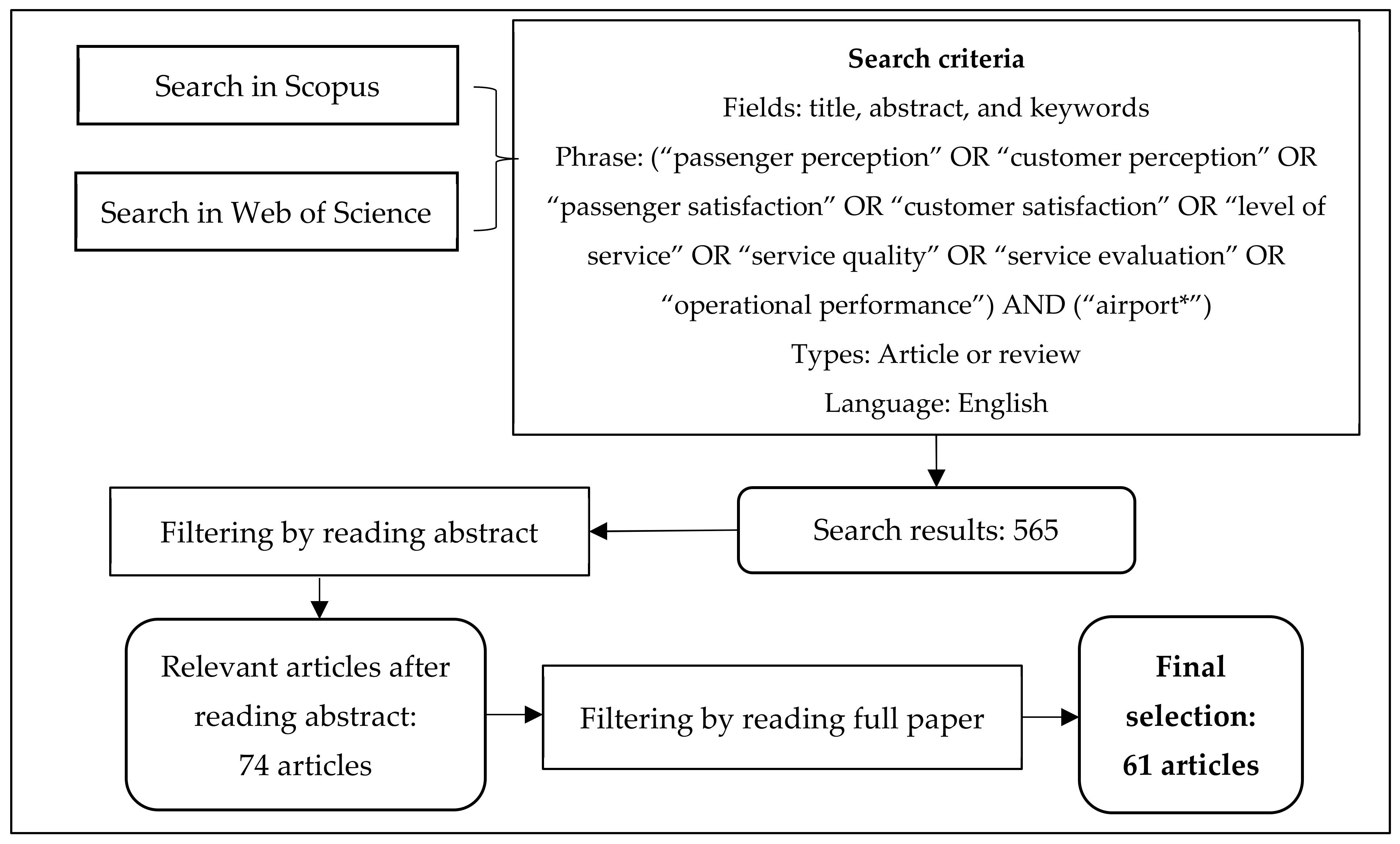
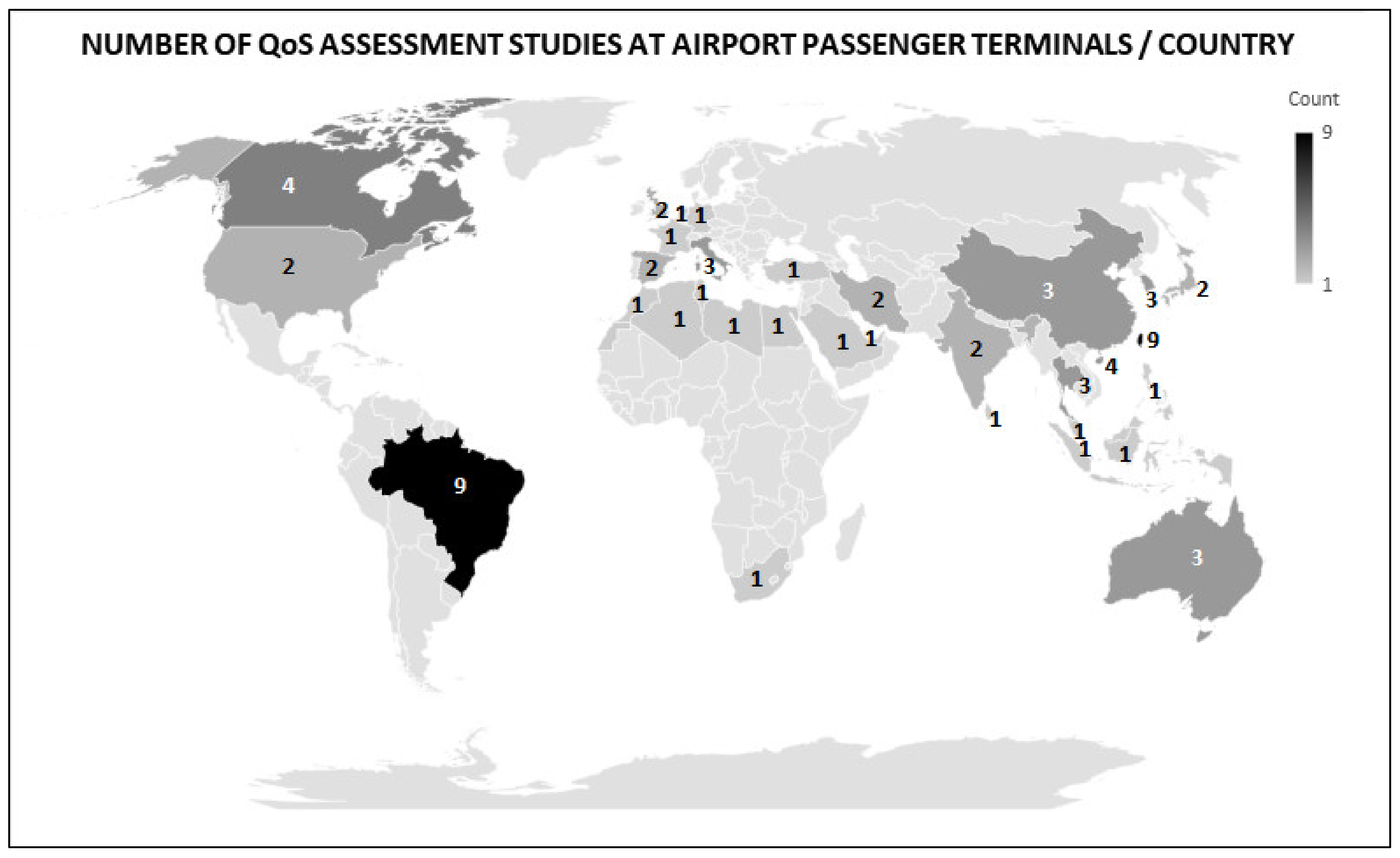
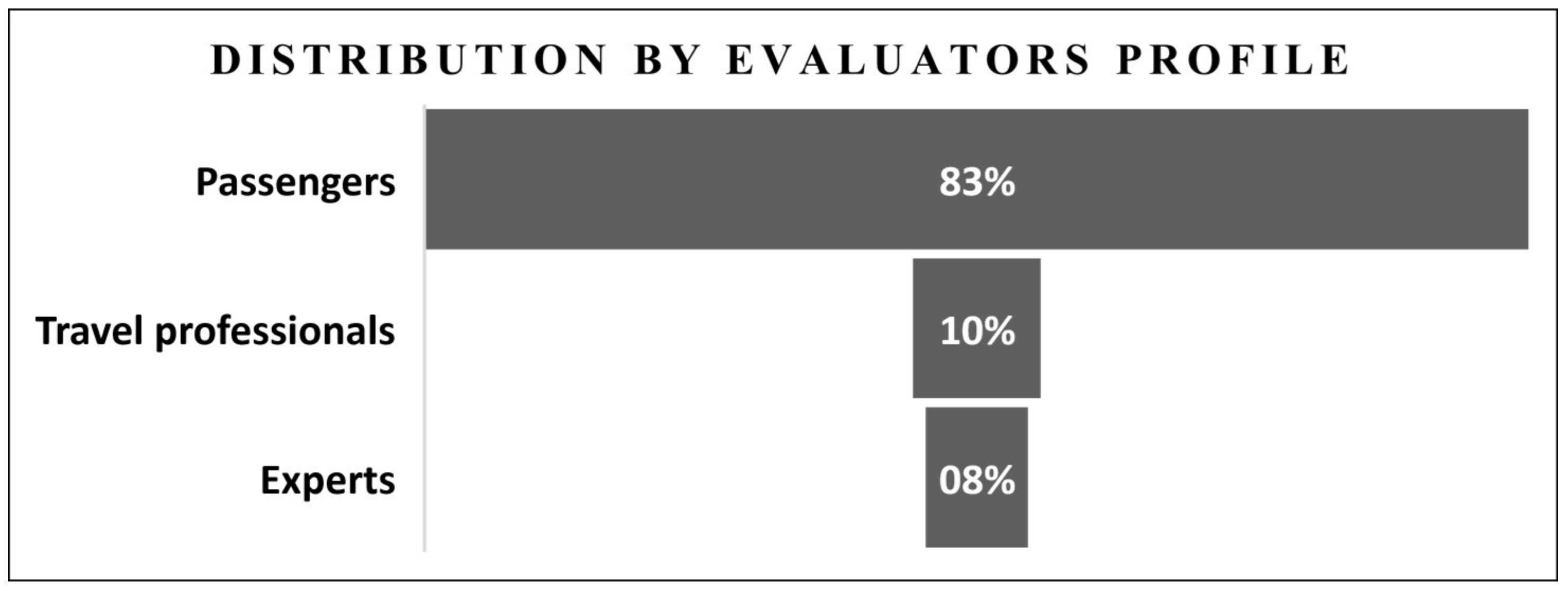
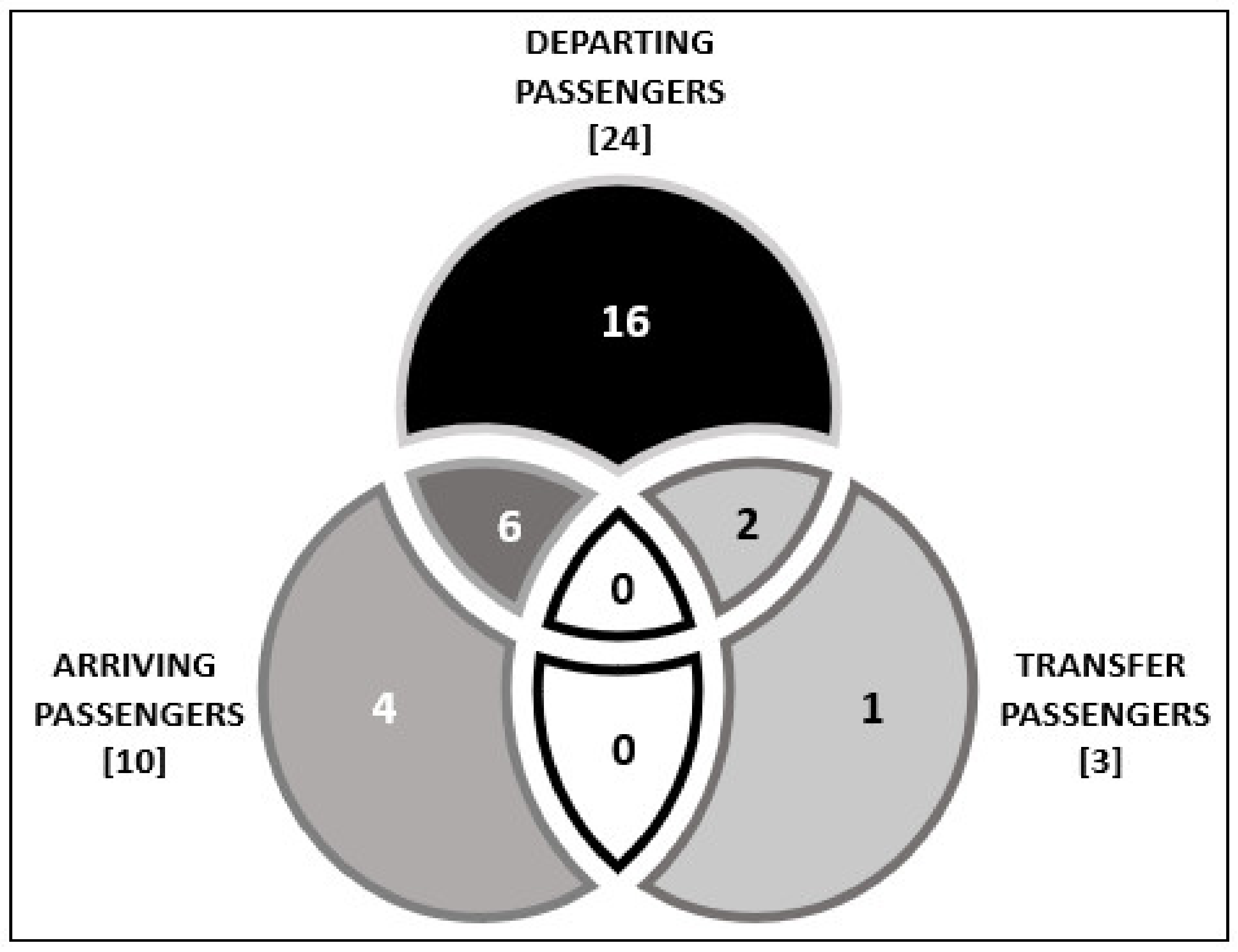
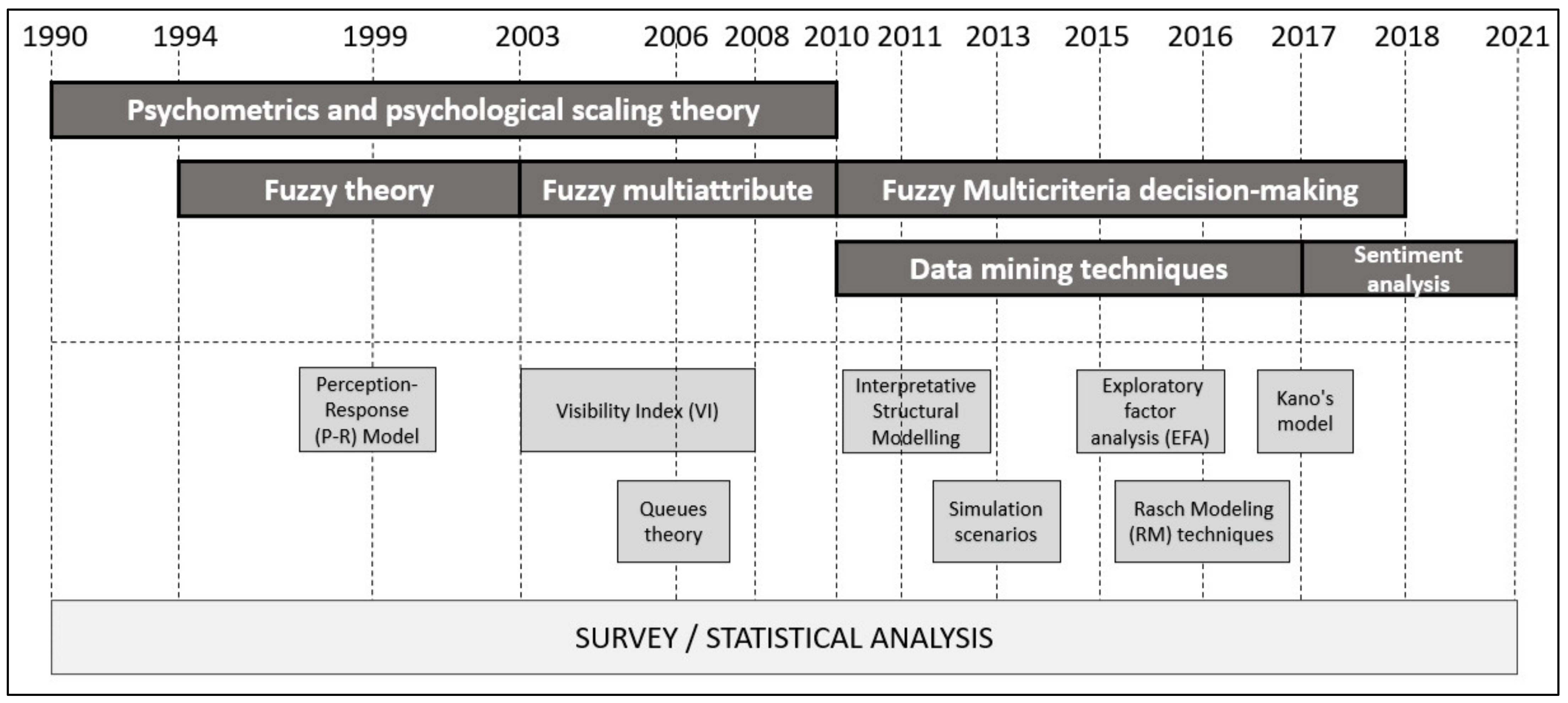
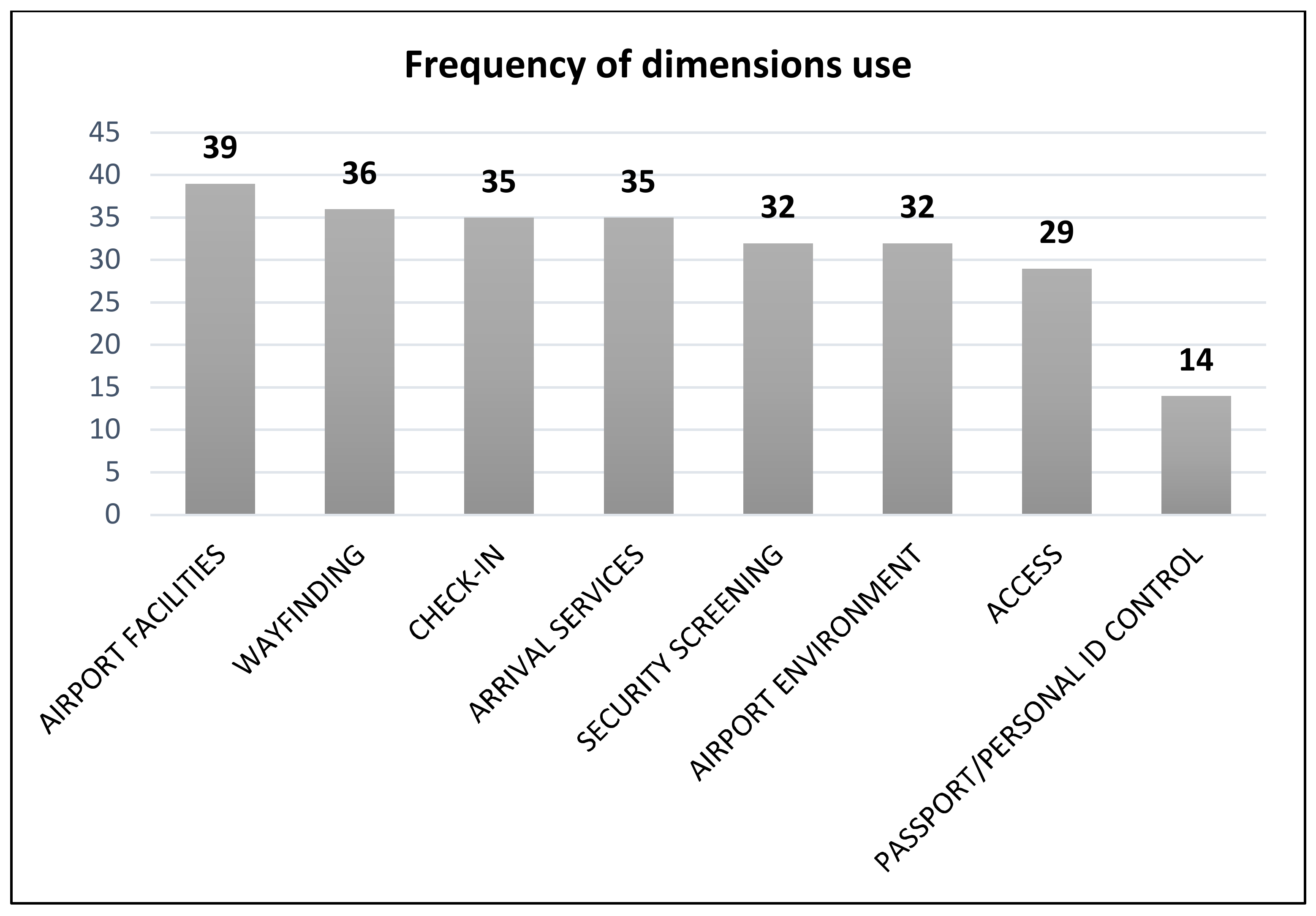
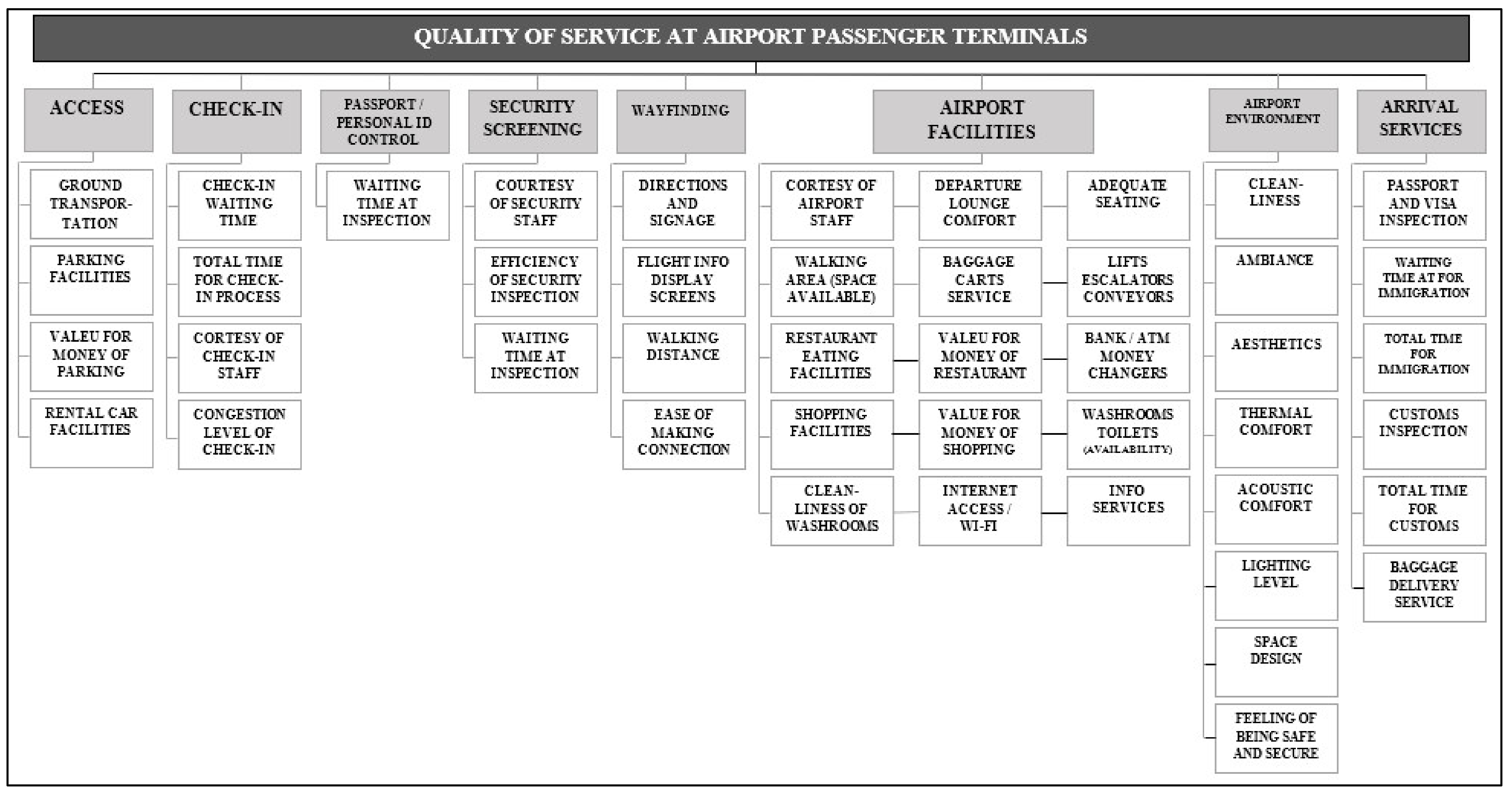
| Database | Number of Articles | Number of Reviews | Total |
|---|---|---|---|
| Scopus | 422 | 56 | 478 |
| Web of Science | 306 | 6 | 312 |
Publisher’s Note: MDPI stays neutral with regard to jurisdictional claims in published maps and institutional affiliations. |
© 2022 by the authors. Licensee MDPI, Basel, Switzerland. This article is an open access article distributed under the terms and conditions of the Creative Commons Attribution (CC BY) license (https://creativecommons.org/licenses/by/4.0/).
Share and Cite
da Rocha, P.M.; Costa, H.G.; da Silva, G.B. Gaps, Trends and Challenges in Assessing Quality of Service at Airport Terminals: A Systematic Review and Bibliometric Analysis. Sustainability 2022, 14, 3796. https://doi.org/10.3390/su14073796
da Rocha PM, Costa HG, da Silva GB. Gaps, Trends and Challenges in Assessing Quality of Service at Airport Terminals: A Systematic Review and Bibliometric Analysis. Sustainability. 2022; 14(7):3796. https://doi.org/10.3390/su14073796
Chicago/Turabian Styleda Rocha, Phelipe Medeiros, Helder Gomes Costa, and Glauco Barbosa da Silva. 2022. "Gaps, Trends and Challenges in Assessing Quality of Service at Airport Terminals: A Systematic Review and Bibliometric Analysis" Sustainability 14, no. 7: 3796. https://doi.org/10.3390/su14073796
APA Styleda Rocha, P. M., Costa, H. G., & da Silva, G. B. (2022). Gaps, Trends and Challenges in Assessing Quality of Service at Airport Terminals: A Systematic Review and Bibliometric Analysis. Sustainability, 14(7), 3796. https://doi.org/10.3390/su14073796






